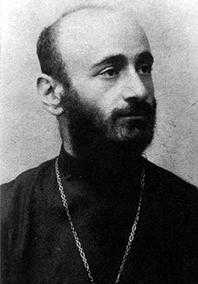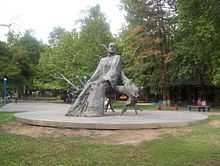Komitas
| Komitas | |
|---|---|
 Komitas in 1902 | |
| Born |
1869 Kütahya, Vilayet of Brusa, Ottoman Empire |
| Died |
22 October 1935 (aged 65–66) Paris, France |
Resting place | Komitas Pantheon, Yerevan, Armenia |
| Nationality | Armenian |
| Education |
Gevorkian Seminary Frederick William University |
| Title | Vardapet |
| Denomination | Armenian Apostolic Church |

Soghomon Soghomonian, commonly known as Komitas (Armenian: Կոմիտաս; Gomidas in Western Armenian) (26 September or 8 October[lower-alpha 1] 1869 – October 22, 1935), was an Armenian priest, composer, choir leader, singer, music ethnologist, music pedagogue and musicologist. Many regard him as the founder of modern Armenian classical music.
Komitas experienced a mental breakdown after witnessing the horrors of 1915 Armenian Genocide and is considered a martyr of the genocide.[2]
Biography
Early life and education
Soghomon Soghomonyan was born into a family whose members were deeply involved in music and were monolingual in Turkish. His mother died when he was one, and his father died ten years later. His grandmother looked after him until 1881, when a prelate of the local Armenian diocese went to Echmiadzin to be consecrated a bishop. The catholicos Gevork IV ordered him to bring one orphaned child to be educated at the Echmiadzin Seminary. Soghomon was chosen among 20 candidates and admitted into the seminary (where he impressed the catholicos with his singing talent) and graduated in 1893, after which he became a monk. According to church tradition, newly ordained priests are given new names, and Soghomon was renamed Komitas (named after the seventh-century Armenian catholicos who was also a hymn writer). Two years later, he was elevated in rank to archimandrite and obtained the title Vardapet (or Vartabed), meaning a "doctor of the church" or "divine scholar".
He established and conducted the monastery choir until 1896, when he went to Berlin, enrolled at Kaiser Friedrich Wilhelm University and studied music at the private conservatory of Prof. Richard Schmidt. In 1899, he acquired the title Doctor of Musicology and returned to Echmiadzin, where he took over conducting a polyphonic male choir. He traveled extensively around the country, listening to and recording details about Armenian folk songs and dances performed in various villages. This way, he collected and published some 3,000 songs, many of them adapted to choir singing.
Activities
His major work is Badarak (Divine Liturgy), still used today as one of the two most popular musical settings of the Armenian Church liturgy or mass, which he started composing in 1892 but never completely finished due to the upcoming World War I. For the basis of the work, he took chants sung by the eldest priests and upgraded it with typical ("cleaned" of foreign influences) Armenian music elements from his collected material. Today the best-known version of Badarak is his favourite for a four-voiced male choir. It must be understood that the Komitas Badarak was not an original composition per se, but rather an arrangement of the pre-existing melodies in use by Armenian priests for the singing of the mass. The words certainly are not original but are the text of the Armenian mass, which has been used for centuries. Armenian Church music was traditionally monophonic, but Makar Yekmalian, Komitas, and several other musician/composers in the 19th and 20th centuries arranged polyphonic versions of the pre-existing melodies. Some composers (but not Komitas or Yekmalian) created completely original musical settings of the liturgy as well.
He was the first non-European to be admitted into the International Music Society, of which he was a co-founder. He gave many lectures and performances throughout Europe, Turkey and Egypt, thus presenting till then very little known Armenian music.
From 1910, he lived and worked in Istanbul. There, he established a 300-member choir, Gusan.
Genocide and death
On April 24, 1915, the day when the Armenian Genocide officially began, he was arrested and put on a train the next day together with 180 other Armenian notables and sent to the city of Çankırı in northern Central Anatolia, at a distance of some 300 miles. His good friend Turkish nationalist poet Mehmet Emin Yurdakul, the writer Halide Edip, and the U.S. ambassador Henry Morgenthau intervened with the government, and, by special orders from Talat Pasha, Komitas was dispatched back to the capital alongside eight other Armenians who had been deported.[3] Details of his deportation can be found in Grigoris Balakian's Armenian Golgotha, during which Komitas suffered tremendously and was afflicted with traumatic neurosis. In one passage Balakian recounts how:
The more we moved away from civilization, the more agitated were our souls and the more our minds were racked with fear. We thought we saw bandits behind every boulder; the hammocks or cradles hanging from every tree seemed like gallows ropes. The expert on Armenian songs, the peerless archimandrite Father Komitas, who was in our carriage, seemed mentally unstable. He thought the trees were bandits on the attack and continually hid his head under the hem of my overcoat, like a fearful partridge. He begged me to say a blessing for him ["The Savior"] in the hope that it would calm him.[4]
In the autumn of 1916, he was taken to a hospital in Constantinople, Hôpital de la paix, and then moved to Paris in 1919, where he died in a psychiatric clinic in Villejuif in 1935. Next year, his ashes were transferred to Yerevan and buried in the Pantheon that was named after him.
Legacy



In the 1950s, his manuscripts were also transferred from Paris to Yerevan.
Badarak was first printed in 1933 in Paris and first recorded onto a digital media in 1988 in Yerevan. In collecting and publishing so many folk songs, he saved the cultural heritage of Western Armenia that otherwise would have disappeared because of the genocide. His works have been published in the Republic of Armenia in a thoroughly annotated edition by Robert Atayan. Lately, nine songs on German poetry, written during his stay in Berlin, have been excavated from the archives in Yerevan and interpreted by soprano Hasmik Papian.
The Yerevan State Musical Conservatory is named after Komitas. There also exists a worldwide renowned string quartet named after Komitas.
On July 6, 2008, on the occasion of Quebec City's 400th anniversary celebration, a bronze bust of Komitas was unveiled near the Quebec National Assembly (provincial legislature, Auteuil street) in recognition of his great input to music in general and to Armenian popular and liturgical music in particular. Previously, a Granite and Bronze statue of Komitas was erected in Detroit in 1981 in honor of the great composer and as a reminder of the tragedy of the Armenian Genocide.
In September 2008, the CD Gomidas Songs, sung by Isabel Bayrakdarian and accompanied by the Chamber Players of the Armenian Philharmonic and pianist Serouj Kradjian, was released on the Nonesuch label. This CD is nominated for a Grammy Award in the Best Vocal Recording category.[5] A major North American tour by Ms. Bayrakdarian in October 2008 featured the music of Komitas, with concerts in Toronto,[6] San Francisco, Orange County, Los Angeles, Vancouver, Boston and New York's Carnegie Hall. She was accompanied by the Manitoba Chamber Orchestra conducted by Anne Manson, and pianist Serouj Kradjian. The Remembrance Tour was dedicated to victims of all genocides and sponsored by the International Institute for Genocide and Human Rights Studies (a division of the Zoryan Institute).
The following landmarks were named after him:
- The central square of Ejmiatsin city is named after Komitas.
- Yerevan State Musical Conservatory is named after Komitas Vardapet.
- Komitas Avenue, the main thoroughfare of Yerevan's Arabkir District, is named after Komitas Vardapet.
- The writers' and poets' pantheon in Yerevan is named after Komitas.
Works, editions and recordings
- The music of Komitas double Lp made to celebrate the centenary of the birth. KCC, 1970
- The Voice of Komitas Vartapet, Komitas Vardapet. Traditional Crossroads, 1995, recorded in 1908/1912[7]
- Gomidas - Songs, Isabel Bayrakdarian, Serouj Kradjian (arrangements and piano), chamber players of the Armenian Philharmonic Orchestra, conducted by Eduard Topchjan. Nonesuch, 2005[8]
- Komitas - Complete Works for Piano, Şahan Arzruni. Kalan, 2012[9]
Works on Komitas
- Kuyumjian, Rita Soulahian (2010). Archaeology of Madness: Komitas, Portrait of an Armenian Icon. Gomidas Institute.
- Nikoghos Tahmizian, Komitas and the Musical Legacy of the Armenian Nation (in Armenian), 1994, Drazark Press, Pasadena, Ca.
References
- Notes
- ↑ Vrej Nersessian gives Komitas' birthday as September 26;[1] however, the Encyclopaedia Britannica has October 8. In 1869 the Ottoman Empire used the Rumi calendar, and September 26 of that year in the Rumi calendar corresponds to October 8 in the Gregorian calendar. It is not clear whether Nersessian has cited the date of the Rumi calendar, or the Britannica has perhaps applied a hypercorrection.
- Citations
- ↑ Vrej Nersessian, ed. (1978). Essays on Armenian music. Kahn & Averill. p. 13. ISBN 0-900707-49-6.
- ↑ Soulahian Kuyumjian, Rita. Archeology of Madness: Komitas, Portrait of an Armenian Icon. Edition: 2, Reading, England: Taderon Press; Princeton, NJ: Gomidas Institute, 2001, p. 3.
- ↑ http://www.devletarsivleri.gov.tr/kitap/belge/992/11.PDF
- ↑ Balakian, Grigoris. Armenian Golgotha. Trans. Peter Balakian and Aris Sevag. New York: Alfred A. Knopf, 2009, p. 66. ISBN 0-307-26288-X.
- ↑ "Bayrakdarian's 'Gomidas Songs' Nominated for Grammy," Loussapatz Weekly (Canada), #772, 2009, p. 41.
- ↑ "Roy ThomsonHall". Retrieved 2008-08-26.
- ↑ http://www.allmusic.com/album/the-voice-of-komitas-vardapet-r223894/review
- ↑ Booklet includes sung texts in Armenian transliteration and English translation
- ↑ Booklet includes a historical discussion of the music in Armenian, Turkish and English
External links
| Wikiquote has a collection of quotations related to: Komitas (Armenian Wikiquote) |
| Armenian Wikisource has original text related to this article: |
- Free scores by Komitas Vardapet at the International Music Score Library Project
- Virtual Museum of Komitas Vardapet
- Isabel Bayrakdarian:Gomidas Songs on Nonesuch
- Biography #1
- Biography #2
- Biography #3
- Some songs in .rm format
- New release of 36 Komitas-songs on SACD by the German independent label AUDITE
- Rita Soulahian Kuyumjian, Archeology of Madness: Komitas, Portrait of an Armenian Icon
- A short movie about Komitas Vartabed
Modern performances
- «Ամպել ա» ("Ampel a", "Clouded Over") performed by the "Dilijan" String Quartet
- «Շողեր ջան» ("Shogher jan") performed by the "Dilijan" String Quartet
- «Կաքաւիկ» ("Kakavik", "Little Partridge") performed by the "Dilijan" String Quartet
|